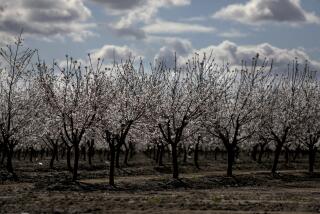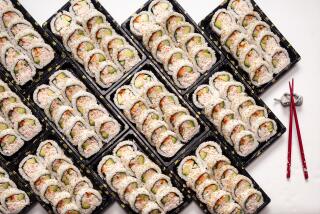Shimmering comeback
Cayucos
It is an odd spot for a miracle, this motley collection of beachfront shacks and sea-scoured concrete tanks clinging to a sunburned bluff above the Pacific just north of Morro Bay. But it’s hard to describe what is happening at the Abalone Farm any other way. Here, the abalone — so rare in the wild that it is illegal to catch it commercially — is making a comeback.
Consider this: Abalone is so tightly protected that it can legally be caught only by sport fishermen north of San Francisco Bay and only if the fishermen are free-diving, without breathing equipment. Anything else is illegal. And yet, abalone appears on the Monterey Bay Aquarium’s list of “best choice” seafood. But only in its farmed form, of course, and that quite likely means that it comes from the Abalone Farm, which accounts for more than half of the fresh abalone eaten in this country.
Abalone was once considered a California icon, as much a part of summer as surfboards, cut-off jeans and bonfires at the beach. It was so common it could be collected from rocks exposed by low tides.
It is a marine gastropod (family haliotidae, genus Haliotis), a snail that lives in the sea. In fact, if you try to imagine a very big, very stylish snail sporting a streamlined shell that looks something like a ‘50s or ‘60s bathtub Porsche, you’ll be very close.
The part of the abalone that we eat is its large muscular foot. Raw, it is very tough. When eaten as sushi, this translates as a pleasing crunchiness. If it is to be cooked, abalone is almost always tenderized by pounding, just as you would flatten a scaloppine of veal or a chicken-fried steak. It must also be heated very quickly or it becomes rubbery.
Properly prepared, abalone has a texture that is nearly buttery. The flavor is beguiling, like a combination of a very sweet, very tender calamari steak with the lingering, subtle shellfish flavor we associate with oyster or crab.
It is no wonder people went so crazy for it. Still, it is a shame. In a relatively short span, abalone went from being almost as common as mussels to so overfished that only last-minute legislation and the intervention of advanced aquaculture could save it from oblivion.
But if you equate modern miracles with high technology, you’ll be disappointed in the Abalone Farm.
The shellfish are kept in a series of plastic buckets and tanks that are housed in what seem like a series of rickety boathouses and barracks. When the abalones are big enough, they graduate to the concrete tanks, roughly 4 feet square and divided by plywood walls.
Because abalones are relatively clean and well-behaved creatures, their aquaculture is regarded as a model of ecological sustainability. They live in seawater that is pumped from the bay below and are fed kelp that is harvested from the forest just beyond where the surf breaks, on dark red dulse seaweed that is grown at the farm and on naturally occurring algae that grow in the tanks.
“We’re very low-tech,” says Brad Buckley, the farm’s sales manager. “We’ve learned we have to work with the abalone on its own natural level. There are no glitzy shortcuts.”
The abalones don’t seem to mind. At any given time, the farm houses between 4 million and 6 million of them. They sell a million a year; most goes to sushi bars in Southern California and the Bay Area, but about a third is shipped to Asia.
As rustic as the setting might be, the Abalone Farm is thoroughly modern when it comes to getting its product out. Almost every day an overnight delivery truck pulls up the dirt road to pick up a load of abalone. Orders placed before noon by phone or on the website can be delivered anywhere in the country the next day.
$100 a pound, uncooked
A couple of times a week, another truck comes in and picks up big loads to be delivered to wholesalers, like Chol Pak’s Pacific Fresh Fish Co. downtown, which sells to Southern California sushi bars and markets such as Assi Market in Koreatown. Because of its scarcity, fresh abalone is extravagantly expensive. Ready-to-cook steaks from the Abalone Farm run about $100 a pound (enough for six to eight moderate servings).Pak says Koreans like abalone as sashimi and also as an ingredient in rice porridge called jeonbok-juk. Another steady customer is the classic Pico Rivera steakhouse Dal Rae, which serves them either “almodine” or served with caper sauce or lemon butter (a $52 entree).
Although the flavor is the same, old-timers who remember wild abalone as big as dinner plates are not likely to be impressed by the size of these farmed specimens. Most are harvested when they’re about as big as your palm. A few super-achievers are as big as your entire hand. The abalones range in weight from 3 1/2 ounces to 8 ounces, which will yield 1- to 2-ounce steaks.
It takes an abalone four years to get to this size, and that is considered the prime of its growth spurt. It may take five or six years more for an abalone to add an extra inch or two. Those hubcap-size monsters you see in old pictures had to have been 40 or 50 years old.
Abalone has been eaten in California for centuries, if not millenniums. Abalone shells are common in coastal middens, ancient garbage dumps left by Native Americans.
The first commercial abalone fishermen were the Chinese, who, beginning in the 1850s, dried them and shipped them back home. In the early part of the 20th century, the Japanese took over and used their advanced knowledge of early deep-sea diving techniques to harvest them more efficiently.
But it wasn’t until after World War II and Jacques Cousteau’s popularization of scuba equipment, which permitted even deeper, less restricted dives and extended stays under water, that fishermen were able to go after abalone in a really big way.
The commercial fishery peaked in 1957 with a harvest of more than 5 million pounds. Beginning in the late 1960s, the bottom fell out. By 1992 the total harvest was 500,000 pounds. Two years later it was 322,000 pounds.
Prices rose with the increasing scarcity. What a diver could get for 100 dozen abalone in the early 1960s he might get for 10 dozen in the 1970s and for a dozen in the 1980s. With that kind of money at stake — it’s estimated that at its peak abalone brought in $20 million a year — the fishery was very hard to regulate. (It still is, though for different reasons: Last month Fish and Game nabbed a couple of poachers by Mendocino with more than 400 abalones in their truck.)
Looking at a graph of abalone landings is like looking at a ball bouncing on a tabletop. For a couple of decades it goes up and down but always maintains a certain minimum level. Then the ball reaches the edge and drops straight down to the floor.
What happened is what biologists call serial depletion.
The abalone family is made up of several varieties, some more desirable than others, some easier to catch than others. As the most desirable, easiest to harvest abalones disappeared, they’d be replaced in the statistics by those that were less desirable and harder to catch. You start out collecting abalones at low tide in Venice and wind up deep-diving for them off the Channel Islands.
Finally, there was almost nothing left.
Gradually, between 1993 and 1997, the commercial abalone fishery in California was shut down.
As guilty as man was in the abalone’s demise, there is no escaping the fact that the shellfish is partly to blame as well. In fact, it seems nearly miraculous that it has survived as long as it has.
In many of the ways that matter most, abalones are extremely inefficient, particularly when it comes to reproducing. They are what are called broadcast spawners, which means they release eggs and sperm into the water when the ocean conditions are just right, regardless of whether another abalone is close by. To produce fertilized eggs, they must truly get lucky.
Because abalones prefer to live in colonies, this usually isn’t a big problem. But in a depleted population with males and females scattered farther apart, there are markedly fewer chances of one abalone’s being close enough to another to mate successfully.
In this way, a bad situation becomes worse with almost lightning speed.
Along comes the otter
Furthermore, though abalones are fecund (a mature female may produce more than 10 million eggs at a time), they are remarkably unsuccessful as parents. Only a fraction of a percentage of fertilized eggs actually makes it to maturity in the wild.The Abalone Farm is considered extremely successful with a survivability rate of between 15% and 20%. Such success in nature would soon mean abalones as common as garden snails.
That would be even truer in the absence of natural predators. And that is pretty close to the situation abalones enjoyed from the middle of the 19th century until the modern fishery started.
Ecologists point out that just as the current abalone situation is the result of an extreme imbalance, so was the period of plenty that preceded it. Abalones were so common only because their main predator, the sea otter, had been nearly exterminated by the fur trade.
Cute and cuddly as they are, otters eat abalone like popcorn. A 60-pound sea otter can consume a quarter of its weight in abalone in a day. And the resurgence of sea otter populations south of San Francisco in the 1970s was a factor in the devastation of the abalone population.
The Department of Fish and Game’s Abalone Recovery and Management Plan puts it plainly: “The influence of sea otter predation on abalone populations is so strong that sport and commercial abalone fisheries cannot co-exist with established sea otter populations.”
(In fact, it adds: “Abalone populations in [S]outhern California are so depleted that the addition of sea otters predation could pose a serious threat to the abalone’s continued survival.”)
Fresh from the farm
For the foreseeable future, anyway, the abalone most of us eat will have to come from aquaculture. California licenses eight abalone farms, though most of these are either still in the research stage or are extremely small.After the Abalone Farm, which sells about 225,000 pounds of abalone a year, the next biggest is the Cultured Abalone in Goleta, which sells about 100,000 pounds a year. US Abalone in Davenport sells about 75,000 pounds a year. The Monterey Abalone Co. in Monterey Bay sells about 50,000 pounds a year.
One of the smallest but most interesting abalone farms is in Oxnard. Proteus Seafarms works out of what looks like a converted maintenance garage in the shadow of Reliant Energy’s giant Ormond Beach Generating Station.
Proteus has only about 20,000 abalones in its tanks, but these are white abalones, so rare they were declared an endangered species in 2001 (most farms raise the red variety). White abalone was once the most highly sought food variety because it is so naturally tender it doesn’t need to be pounded.
But it is extremely hard to find, even in the best circumstances.
In fact, it wasn’t even discovered until more sophisticated diving equipment became available in the 1940s because it lives only in depths of greater than 80 feet. Once it was found, it was avidly fished. It is estimated that the number of white abalone has declined 99% in the last 25 years.
Because white abalone are so scarce and live so deep, current estimates of the population are all over the map, ranging from 3,000 animals to 15,000.
But even the best-case scenario still means that Proteus has more white abalones in its garage than live in the entire Pacific Ocean.
Proteus director Thomas McCormick says he hopes next year to be able to release the first mature white abalones back into the wild, with the help of California Department of Fish and Game, the National Marine Fisheries Service, the Channel Islands National Park and the Channel Islands Marine Sanctuary. After that, his goal is to be able to plant 5,000 a year.
Proteus is a nonprofit corporation, and McCormick’s primary goal is research. Asked about the white abalone’s potential for food, he almost blanches, but he understands. It goes with the territory when you’re trying to resurrect one of the ocean’s most delectable creatures.
“One of the things about the white abalone is that we really don’t know anything about it other than it tastes good,” he says. “It was revered. The fishermen always kept white abalone for their own consumption because it was so tender.
“What we’re trying to do is slowly build a new population structure. But I don’t know whether we’ll ever see a self-sustaining population again.”
*
Putting abalone
on the table
There are two ways to purchase farmed abalone: as tenderized steaks, which have been pounded and come shrink-wrapped, or live in the shell. Live in-the-shell abalone will yield about a third of its weight in steaks.
The Abalone Farm: Tender- ized steaks shipped overnight, $105 for 16 (1-ounce) steaks, including shipping.
(877) 367-2271. https://www.abalonefarm.com
Monterey Abalone Co.: Live in the shell. $20 per pound, plus shipping. (831) 646-0350. https://www.montereyabalone.com
US Abalone: Live in the shell. $30 per pound (2-pound minimum order), plus shipping. (888) 222-5663. https://www.usabalone.com
Los Angeles Fish Co.: Live in the shell. $23.95 per pound. 420 Stanford Ave., Los Angeles. (213) 489-4236.
Russ Parsons
*
Abalone carpaccio with scallions, ginger and ponzu
Total time: 20 minutes
Servings: 2
Note: From Kazuto Matsusaka, chef-owner of Beacon in Culver City.
Ponzu
1 tablespoon mirin
1 tablespoon rice wine vinegar
1 1/2 tablespoons fresh squeezed lemon juice
2 tablespoons soy sauce
1. Place the mirin in a small sauté pan and heat over very low heat. Ignite it with a fire starter or long match and flambé to burn off the alcohol. Let it cool slightly.
2. Combine the mirin, vinegar, lemon juice and soy sauce in a small bowl and set aside.
Abalone
2 fresh baby abalone, sliced paper thin
1 cup boiling water
3 tablespoons extra virgin olive oil
1/2cup green onion julienne strips (2 inches long)
1/4 cup peeled and finely julienned fresh ginger (2 inches long)
Kosher salt
Fresh ground black pepper
2 tablespoons ponzu
1. Place the sliced abalone in a strainer over a bowl so that the slices are not overlapping. Slowly pour the boiling water over the abalone to quickly cook. The abalone should turn whiter.
2. Arrange the abalone slices on two plates.
3. Warm the oil in sauté pan (do not heat it to smoking) and quickly cook the green onion and ginger slices for about 5 seconds. Season with salt and pepper. Using small tongs or chopsticks, remove the green onions and ginger from the pan and evenly distribute over the abalone slices.
4. Drizzle ponzu over the scallion mixture and serve as a simple appetizer with a green salad or as an entree with steamed rice.
Each serving: 267 calories; 11 grams protein; 9 grams carbohydrates; 1 gram fiber; 21 grams fat; 3 grams saturated fat; 48 mg. cholesterol; 579 mg. sodium.
*
Crisp abalone steak
Total time: 15 minutes
Servings: 4 to 6
1pound abalone steaks, pounded thin
Salt
1 egg white
1 teaspoon water
1/4cup vegetable oil
1/4cup ( 1/2 stick) butter, divided
1 cup fresh bread crumbs
Juice of 1/2 lemon
1 tablespoon minced parsley
1. Lightly season the steaks with salt. Lightly beat together the egg white and water. Heat the oil and 2 tablespoons butter in a large heavy skillet over medium-high heat. Place the fresh bread crumbs in a wide mixing bowl.
2. Dip the steaks in the egg white mixture and shake off any excess. Place the steaks in the bread crumbs and press firmly to coat well on both sides.
3. Fry the steaks in the oil-butter mixture just until lightly browned, about 20 to 30 seconds per side. Remove to a warm platter.
4. Empty the pan, wipe it clean and return it to high heat. Add the remaining butter and let it sizzle madly. When it has completely melted and is just beginning to brown, squeeze in the lemon juice. Remove the pan from the heat and stir in the parsley. Season lightly with salt and pepper. Pour the sauce over the abalone and serve immediately.
Each serving: 194 calories; 14 grams protein; 8 grams carbohydrates; 0 fiber; 11 grams fat; 4 grams saturated fat; 80 mg. cholesterol; 278 mg. sodium.
More to Read
Sign up for The Wild
We’ll help you find the best places to hike, bike and run, as well as the perfect silent spots for meditation and yoga.
You may occasionally receive promotional content from the Los Angeles Times.











